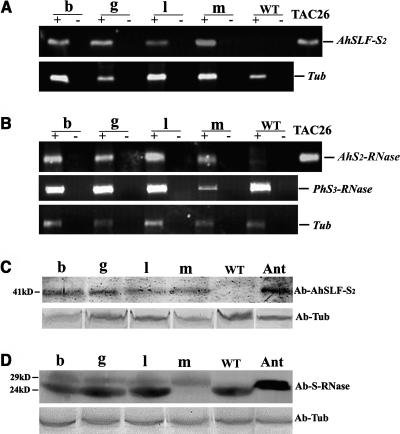Figure 2.
Expression Analysis of AhSLF-S2 and AhS2-RNase in the Transgenic Petunia Lines.
(A) and (B) RT-PCR analysis of RNA isolated from pollens or styles, with (+) or without (–) reverse transcriptase in the synthesis of cDNA.
(A) Top panel, RT-PCR analysis of RNA isolated from pollen of the transgenic lines b, g, l, m, and S3S3 wild-type petunia plant using specific primers of AhSLF-S2. TAC26 plasmid (TAC26) was used as a positive control. Bottom panel, RT-PCR analysis of tubulin for loading control.
(B) Top panel, RT-PCR analysis of RNA isolated from styles of transgenic lines b, g, l, m, and the wild type using specific primers of AhS2-RNase, and the TAC26 plasmid (TAC26) was used as a positive control. Middle panel, RT-PCR analysis of RNA isolated from styles of the trangenic lines using specific primers of PhS3-RNase. Bottom panel, RT-PCR analysis of tubulin for loading control.
(C) and (D) Immunoblot detection of AhSLF-S2 or S-RNases.
(C) Top panel, detection of AhSLF-S2 from total pollen proteins of transgenic lines b, g, l, m, and wild-type S3S3 petunia plant and Antirrhinum of S2S4 (Ant) by polyclonal antibody against AhSLF-S2. Bottom panel, detection of tubulin for loading control.
(D) Top panel, detection of AhS2-RNase (∼29 kD) and endogenous S3-RNase (∼24 kD) from total style proteins of transgenics lines b, g, l, m, wild-type S3S3 petunia plant and Antirrhinum (Ant) by polyclonal antibody against AhS-RNases. Bottom panel, detection of tubulin for loading control. Sizes of the detected protein bands are indicated in kilodaltons.

